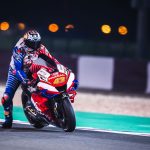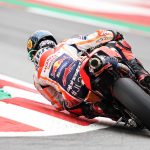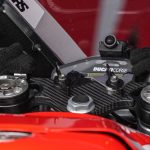And Dovi makes it nine. When Andrea Dovizioso’s Ducati Desmosedici GP crossed the line to take victory at Sepang, the 2016 MotoGP season entered the record books. For the first time in Grand Prix history, nine different people had won races in a single season. Dani Pedrosa’s success at Misano had tied the previous record, the 2000 season seeing eight different riders all prevail in the same year. But a ninth winner is unprecedented.
Where did this wild year come from? There are a lot of reasons. New tyres, of course, some riders adapting better to the Michelins than others, and teams learning more about how to get the best out of them at every race. New electronics too, with Magneti Marelli supplying software for their spec hardware, putting all of the MotoGP factories at the same level, taking away the advantage which Honda and Yamaha had over the rest. And a competitive field, of course: we have never seen this depth of talent in terms of both riders and bikes before.
But perhaps this whole wild and wonderful season has its roots elsewhere, a year ago and half a world away. Perhaps the 2016 season started two years ago, in the Eastern Pacific. The upwelling of cold water that feeds the western coast of South America weakened, and the warm surface water from the Western Pacific spread eastwards. That signalled the start of a weather phenomenon called El Niño, which brings drastic changes to the weather in large parts of Asia, and South and Central America. The 2014 El Niño was one of the most powerful in recent history, lasting through to the start of 2016.
It isn’t just the Pacific affected by El Niño. The changing trade winds and higher ocean surface temperatures slowly, and gradually have knock on effects all over the world. With a delay of a year or so, weather patterns in Europe shifted, the high pressure systems coming from the huge landmass of Russia and Eurasia lessening in importance. The weather in Europe – and especially the parts of Europe where they race motorcycles – is sometimes cooler than normal, and often wetter.
Colder and wetter is exactly what we have seen in MotoGP this season, and in combination with the other factors, has made for a fascinating term. Michelin, after all, did their first batch of development in 2014, when Kenny Noyes tested their slicks in Europe with the Kawasaki ZX-10R that he would use to go on and win the Spanish CEV Superbike championship. Factory test riders from Honda, Yamaha and Ducati started testing the Michelins later that year, and throughout 2015, they tested at almost every circuit on the MotoGP calendar, either before or after the race there. That data gave Michelin a baseline to start to build their tyres with. It was their starting point for the 2016 season.
The trouble is, the weather in 2015 was fairly typical, a warm, mostly dry summer in Europe. The real effects of El Niño in this part of the world didn’t hit until 2016. So several times this year, Michelin found themselves at a track where the temperatures and conditions were not what they had expected. The problems started in Argentina, where it was much warmer, with track temperatures 20°C hotter than last year. The combination of heat and a dirty track stressed the tyres, and caused Michelin to rethink their designs. Back in Europe, conditions were often colder than expected, meaning the harder compounds Michelin had brought were not working the way the riders had anticipated.
And of course there was the rain. We had a lot of wet races. It was damp in Argentina, then absolutely soaking at Assen. Both Sachsenring and Brno started out wet, the track drying out during the race. Sometimes it just rained during practice, leaving the riders with no idea of a dry set up, such as happened at Phillip Island [Red Bull Ring was a narrow escape! – ED]. Teams were left to make their best guess at a set up, and then cross their fingers for the race.
All of this provided a thrilling combination. New electronics meant that the teams had to spend a long time trying to figure out how to use them best, and trying to establish a base set up which would provide a starting point for each weekend. New tyres meant that the teams had to try to figure out the right weight distribution between front and rear, to provide the best rear grip for drive out of corners and the best front grip for corner entry and carrying corner speed. They had to try to understand how the Michelins behaved over race distance, how quickly they would show signs of degradation, and how best to manage that with only two different traction control settings and a couple of engine braking settings. Riders had to unlearn old habits picked up from racing Bridgestones, and try to learn new habits that would work with the Michelins. The historical set up advantages of the established factories were gone.
There are also more bikes capable of being competitive on the grid. In years past, only the factory Hondas and Yamahas were in contention, and Casey Stoner on the Ducati. But since Gigi Dall’Igna has taken over, the Ducati is a very solid all round bike, and they have gained an advantage using winglets to compensate for the loss of electronics. Suzuki have made massive steps forward with their 2016 bike, and it is not far off where the Yamaha and Honda are. Even Aprilia has made real progress though this season, though they still lag significantly behind the other four.
All of these factors take nothing away from the athletes who have won. Every single one of them has proven themselves in the heat of battle. Of the nine winners of a MotoGP race this season, all but Andrea Iannone and Jack Miller have not won a world championship (Cal Crutchlow, of course, was World Supersport champion in 2009). Miller was runner up to Alex Márquez in Moto3 in 2014, and Iannone finished third in Moto2 in all three years he was in the class. All but Cal Crutchlow had won races in Grand Prix before, though Miller, Iannone and Viñales had only won in Moto3 and Moto2. These are all top flight riders, the best in the world.
2016 demonstrates what can happen when you put a hugely talented field on competitive bikes, and have them race together with relatively little set up data and in unpredictable conditions. Any number of riders can conquer, which is fantastic for the sport. But a repeat of 2016 is unlikely in the future. Next year, the factories will have much more data, the tyre designs will be much more stable, and the weather is likely to return to normal, giving the teams much more set up time. Thankfully, what remains are a field full of talented riders on bikes that are all pretty well matched. We may not see nine winners in a season again but it’s a given that at the start of every race next season there will be six or seven riders capable of winning it. This is truly a golden age of MotoGP.
Photo by CormacGP








